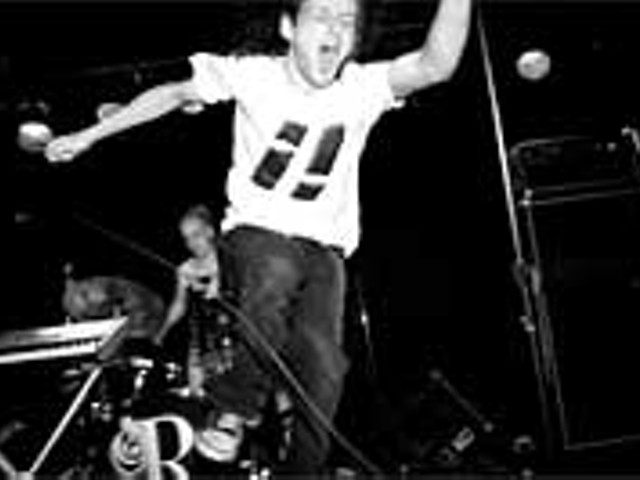A skriker, if you haven't had the privilege of hearing one, is a horrific, unearthly sound. The Oxford English Dictionary describes it as a cross between a scream and a shriek. Caryl Churchill's 1994 play by the same name depicts a shape-shifter in an urban fairy tale about the nature of evil. The plot includes stolen and murdered babies, and even some blood-drinking. As if it weren't creepy enough already — for its local debut at Henry Ford Community College, this Skriker looms in high-tech 3D.
A British author of more than 30 plays, Churchill must have been real angry — about the world's swelling population, dwindling resources and stifling poisons — when she wrote this one. (Her only other play in metro Detroit this season, A Number, scheduled for Planet Ant next February, deals with cloning.)
The plot concerns two sisters, Josie and Lily; Josie has murdered her baby and Lily is pregnant. Like Mephistopheles in Faust, the Skriker appears in a human guise. The creature tries to win Lily's love — and her child. In a series of encounters that convey Churchill's pessimistic worldview, the Skriker assumes different human forms and eventually steals Lily's soul. The play can be read as the loss of humanity in an increasingly soulless world.
"Goblins, Spriggans, Bogles, Elves, Fairies, Brownies ... represented man's organic, and more ancient connection to the world: a way of understanding an existence in which it was imperative to live in balance with nature," Churchill wrote when the play opened eight years ago.
George Popovich is chair of Henry Ford Community College's theater department. About Churchill's play, he says, "It cried out motion-capture to me." Churchill's cast of creatures references Celtic myth, and Popovich thought there'd be no better way to depict them than in his Virtual Theatricality Lab, with a digital beast and live actors on stage interacting.
The most familiar uses of motion-capture to date have occurred on film, in two blockbuster productions, The Lord of the Rings and last year's King Kong. In both films, actor Andy Serkis wore digital sensors and acted out the parts of the Golum and Kong; his movements were grafted onto a computerized image and the result was an animated character.
HFCC's Virtual Theatricality Lab, of which Popovich is also the director, functions as a division of the theater department. He says he got the idea for the lab watching the movie The Lawnmower Man back in the early '90s: "The film contained computer-generated 'virtual reality' images, and I thought it would be a gas to do that onstage." He researched and experimented with the technology. After nine years of work, Popovich and his staff and students presented Shakespeare's The Tempest in April 2003, incorporating digital images into the play. For example, Ariel, the sprite who travels around the world performing tasks for Prospero, was computerized and took the form of a robot.
That production made it to the finals of the American College Theatre Festival in Washington, D.C., in 2003. Subsequently, the Henry Ford Community College Technical Improvement Fund gave Popovich $115,000 to continue VTL's mission, which is "dedicated to forging the live performance technology and styles of the next millennium."
For The Skriker, HFCC's theater looks much like a traditional stage, with one large screen center rear and two smaller screens stage right and left. All audience members are given polarized glasses to wear. The onscreen image of the Skriker, a grotesque Golum-like figure, is performed by actor Hugh Duneghy, wearing a motion-capture suit. The skriker also appears in human form, played by actress Laura McCallum, whose movements shadow the digital puppet down to lip-synching. Popovich describes this as an avatar approach — the incarnation of a deity in earthly form. But he hastens to add there are no changes to Churchill's text. The opening monologue — some have compared its language to that of James Joyce — is full of puns, poetic language and references to other literary works, as in this excerpt: "... out of her mouthtrap, out came my secreted garden flower of my youth and beauty and the beast is six six six o'clock in the morning becomes electric ..."
Previous American productions of The Skriker have featured puppets — Dallas in 2005 and Houston earlier this year — and others have emphasized outlandish costumes and props. The New York production at Joseph Papp's Public Theatre in 1996, honored with six Drama Desk awards in the 1996-97 season, broke no new ground in production. Ben Brantley, the New York Times critic, called the play "a toxic variation on A Midsummer Night's Dream."
With creature and expressionistic digital scene design by VTL's Chris Dozier and John Wilson, this is the first time, then, that motion capture has been used in a production of this play, and, as far as Popovich knows, the first time it has been used outside of motion pictures. (There is an Epcot exhibit, "Turtle Talk with Crush," that uses a similar technique, though in real time.) When the history of theater in the 21st century is written, Popovich and the VTL may well make for a paragraph or two. There are only a handful of university theater departments offering opportunities for digitally enhanced presentations, and most of those are in the realm of performance art. Popvich says the University of Kansas was going strong on the scene for a while, and then stopped. But no one has ever attempted motion-capture in a play on stage. HFCC offers cutting-edge theater for a new millennium at a ticket price of only $15.
The Skriker is at 8 p.m., Wednesday, Nov. 29, through Saturday, Dec. 2, at the Adray Auditorium on Henry Ford Community College's campus, 5101 Evergreen Rd., Dearborn; 313-845-6478.
Michael H. Margolin writes about the performing arts for Metro Times. Send comments to [email protected]





